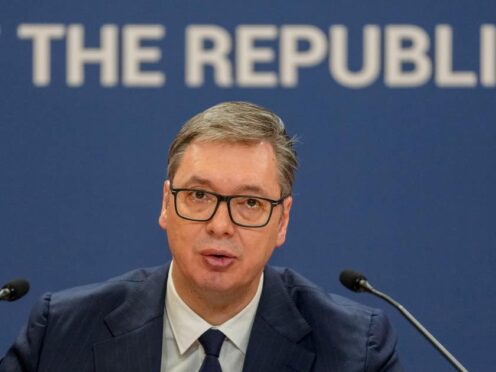
Serbia has sent a note of protest after Croatia’s foreign minister described President Aleksandar Vucic as a Russian “satellite” in the Balkans.
It was the latest spat between the two neighbours, which have been at odds for most of the time since the bloody breakup of Yugoslavia in the 1990s.
Croatian Foreign Minister Gordan Grlic-Radman told N1 television on Saturday that Mr Vucic must decide which side he is on, Russia or the European Union, “because it is impossible and uncomfortable sitting on two chairs at the same time”.
“He shouldn’t have a big dilemma,” Mr Grlic-Radman said, saying that Mr Vucic can remain Moscow’s ally but “malign” Russian influence that could undermine the stability of the Western Balkans will not be allowed.

The populist leader and other Serbian officials reacted with anger.
“The Croatian minister not only brutally interferes in the internal affairs of Serbia, but as usual he lies and insults the Serbian people and threatens its citizens,” Mr Vucic said on Instagram.
“Grlic-Radman is right about one thing, maybe I am someone’s satellite … but I have never been anyone’s servant, which cannot be said for Grlic-Radman.”
In its protest note, the Serbian Foreign Ministry said that it expects that in the future, Croatian officials “will refrain from statements that represent interference in the internal affairs of Serbia, and will lead a policy of reconciliation and good-neighbourly relations between the two states.”
Reacting to the protest note, the Croatian Ministry of Foreign and European Affairs rejected the allegation that Croatia is interfering in Serbia’s internal matters, pointing out that the Croatian official “stated the fact about Serbia’s nonalignment with the foreign and security policy of the European Union regarding the Russian aggression against Ukraine”.
“As we have already pointed out, no one can be a candidate for EU membership and use all the benefits of that, while unprincipledly and calculatedly avoiding condemnation of the Russian aggression and EU policy related to it,” the Croatian ministry said.
Mr Vucic’s government has maintained close ties with Moscow despite its full-scale invasion of Ukraine, and the Serbian autocratic leader has often boasted about his close personal relations with Russian President Vladimir Putin despite Serbia’s formal bid to join the European Union.
Serbia has refused to join Western sanctions against Russia, a traditional Slavic ally, while allowing Moscow propaganda outlets such as RT and Sputnik to spread their narrative throughout the Balkans.
EU officials have repeatedly said that Serbia must align its policies with the bloc if it really wants to join, and warned of the increasing Russian influence in the war-torn region.
Croatia, which is an EU and Nato member, and Serbia have been involved in a series of disputes between their officials in recent years. The two countries have lately also been involved in a mini arms race that analysts believe could further escalate the tensions in the region.

Enjoy the convenience of having The Sunday Post delivered as a digital ePaper straight to your smartphone, tablet or computer.
Subscribe for only £5.49 a month and enjoy all the benefits of the printed paper as a digital replica.
Subscribe